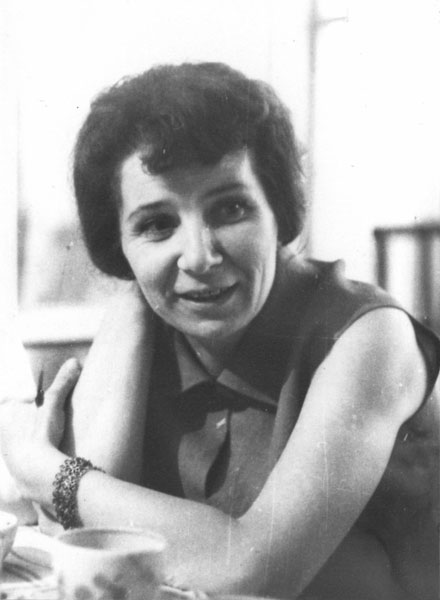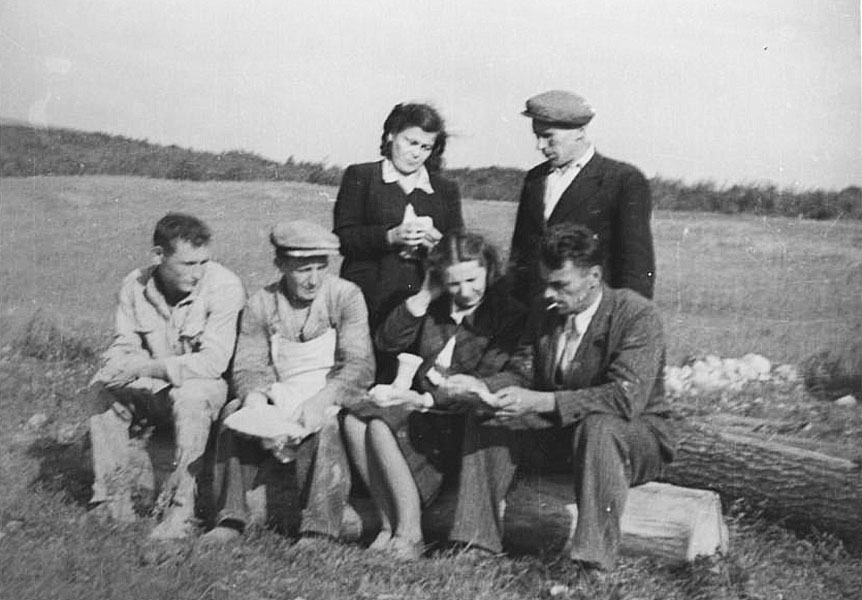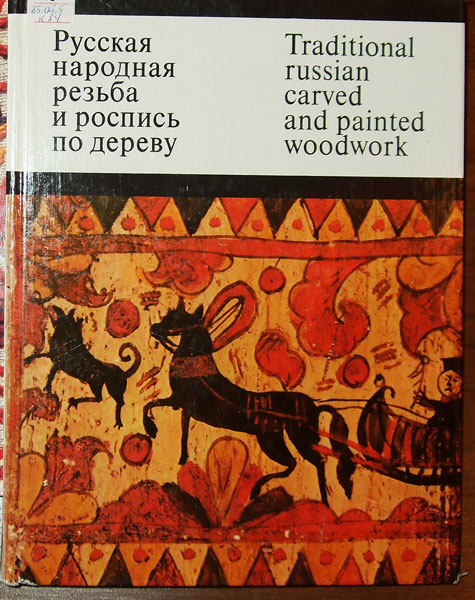Memoirs of Kruglova Olga Vladimirovna
From Tarnoga to Paris
 It is winter in Zagorsk now. The trees bent howling in cold wind at my window. It is white all round. And on a day like I happen to recall the sandy land of Tarnoga burning under the hot summer sun. Through the bus window I saw gently sloping hills running ridge after ridge. Here and there were golden fields of cereals or blue flax, or colored meadow carpets. At a distance there was a virgin forest with no end in sight. The sun was scorching unmercifully. The intense heat covered the whole land. Roaring streams and small rivers attracted us. But we were going on along a dry dusty road passing by all big and small bridges. The engine of our old bus was extremely hot. The open windows were broken and could not be shut. Through the holy floor there penetrated so much hot dust that we could see neither the scenery, nor our neighbors any longer. We all coughed trying to tie kerchiefs and even handkerchiefs around our mouths and noses. Sand was crunching not only on our teeth but in our eyes. My black coat became light sandy, so I could write something with my finger on it. It seemed to me as if I were not in the Tarnoga district of the Vologda region but in some hot desert.
It is winter in Zagorsk now. The trees bent howling in cold wind at my window. It is white all round. And on a day like I happen to recall the sandy land of Tarnoga burning under the hot summer sun. Through the bus window I saw gently sloping hills running ridge after ridge. Here and there were golden fields of cereals or blue flax, or colored meadow carpets. At a distance there was a virgin forest with no end in sight. The sun was scorching unmercifully. The intense heat covered the whole land. Roaring streams and small rivers attracted us. But we were going on along a dry dusty road passing by all big and small bridges. The engine of our old bus was extremely hot. The open windows were broken and could not be shut. Through the holy floor there penetrated so much hot dust that we could see neither the scenery, nor our neighbors any longer. We all coughed trying to tie kerchiefs and even handkerchiefs around our mouths and noses. Sand was crunching not only on our teeth but in our eyes. My black coat became light sandy, so I could write something with my finger on it. It seemed to me as if I were not in the Tarnoga district of the Vologda region but in some hot desert.
At last the bus stopped in the centre of the big village, and not at the bridge over the river of course, but near the shop at the sandy square which was hot as a brazier. I decided to get out. It was Ilezsky grave-yard, upper reaches of the Kokshenga. That was the beginning of my expedition to the land of Tarnoga on the banks of the river, which once was big and deep. The village, where I was to work that day, was, like the road in quicksand. I walked, as usual, from house to house. My feet sank into sand up to my ankle. My boots and socks were covered with hot sand. It was hard to find coolness in houses in such weather as well. I could not possibly ask the hostess to invite me to the cellar! The talk usually started on the porch and lasted for a very long time. And porches there, like anywhere at the North, were built right in the sun. It was bad luck, indeed. I hardly stood such “African” heat with my weak heart. I felt as if I had faded, like a picked blade of grass. I lacked energy, initiative, my head worked slowly. I was frightened at the thought that the weather was not for me and I could ruin the expedition, if it did not rain the following day. But nobody expected rain. They said: “It is always like that at this season”. The time was hot in a literal and in a figurative sense.
The women were seldom in. There were only old people and children. It was also an obstacle. But even under such unfavorable circumstances I managed to collect for the Museum quite a number of valuable works of art that day. In the evening I took the same bus back to Tarnoga with a heavy load. The day was not wasted, but a sharp pail, as a foil, ran through my heart.
«Что же мне делать? Что делать мне? Как поступить, чтоб не сорвать экспедицию?» — это не выходило из моей головы.
“What should I do? What can I do? How should I act not to ruin the expedition?” – the question did not go out of my mind. It was late (but it was not dark at white nights), when the driver took me to the Post Office in Tarnoga. I carried my load up to the second floor, where the Telegraph was and, as always, asked the telegrapher to keep my museum items for some days. An elderly man turned to me from the telegram window and said:
- You look, like a cloud of clay.
- It is always so, commented the telegrapher, - all our buses are old and our roads are sandy. And this is the result. We all get out of the bus like that.
We went out and my companion helped to shake dust off my clothes. Shaking my coat, he ran from a cloud of dust. He repeated the procedure several times. Meanwhile I sat down on the bench, took my tablets, rub dust of my face and beat sand out of my bag. I felt better. The pain would stop soon.
- Well, let me introduce myself, - said the stranger cheerfully.
- Especially, as I can see your face now.
He saw that I could not take my breath and sat down beside me. He happened to be an actor and a manager of a small group from the capital. Their group was to go from Tarnoga to the most remote and wild corners with concerts every day. They had a new hermetical bus of the Vologda Philharmonic Society. And they were only seven.
- Oh, how rich you are! – I cried from the bottom of my heart.
And then I said, what I was and why I was in Tarnoga. I also told him that I was afraid I would fail to fulfill my task because of the weather:
- It is real Sahara! Even my strong character did not help me today.
— - Well, let’s travel together! I’m sure it’ll be easier for you. We leave in the evening, give three concerts at different places and come back at night. In the morning and hot noon we have rest in the Peasant House. And at three in the afternoon we leave again. It seems a good schedule. I think that in such hot weather the real life starts in the evening. People do not go to bed before midnight at white nights. Come with us. We’ll go to our concerts and you’ll collect distaffs.
When we reached the Peasant House he reminded that they would leave at three.
— We’ll be waiting for you! Good bye. We’ll be glad to help you.
The next morning I worked quite successfully in Tarnoga and at three in the afternoon the small traveling group greeted and friendly accepted me in the bus. Since that day we did everything together.
I quickly got used to the new time-table. Usually I got out before the place, where the first concert was given. So, I started to work at 5 or 6 o’clock in the evening. It was not so hot, and people returned home from the fields by that time. While the actors’ group traveled from place to place I worked without haste in some village till midnight. I worked for six or seven hours, when it was cool, when my head was fresh and when all people were at home. Then I carried whatever I collected to the road and waited for my companions. Experienced in walking tours, I helped my new friends to find a nice place in Tarnoga, where we could have a good rest and store up energy for the next night trip.
I persuaded them to have a square breakfast in the canteen at 6 o’clock in the morning and to go right through the pine forest, where the Palace of Culture was, to the ancient city rampart which was above the Tarnoga River. It was not a long way at all. It was a fascinating place in the outskirts of Tarnoga. The whole rampart was covered with pines. A soft carpet of dry moss and pine needles on sandy earth waited for us every day. A light breeze kept off mosquitoes – a great comfort in the North. The river at the foot of the rampart was transparent, like a tear, and hot to the hot sand on the bottom. And there were such smells around! The pines cried with pitch in the sun. The strong pine smell turned our heads. The herbs, high and strong, were in blossom. And the Tarnoga River brought the smell and taste of the forest to its mouth. We did not mind its shallow water at all. After the hard night we all liked to lie still and silent in its slow current. The river was soft and odorous.
Then we slept from seven to twelve under the pine trees and, when it got very hot, we went into the river again. By day we bathed, making much noise and joking to drive our dream off. At one o’clock we had lunch. From two to three – preparations: post-office, telegraph, checking costumes, and I collected the day before. At three o’clock we left again. So, we slept for five hours under the pines, had two meals a day and used the clean river instead of a hand washer in the Peasant House.
All the rest was work and road – twelve, or rather fifteen hours every day. I was delighted with such arrangement. I began to like my Sahara. And I did quite a lot in the Tarnoga district..
The most important thing was that I filled a white spot in our rich collection of Russian distaffs. I found the famous Tarnoga distaff, the most characteristic of the Vologda land. It is of a root type, made of a single piece of a tree. The huge blade is on a small lower part. It is a real giant, cut, as they say, of the whole forest. Such distaffs can be made only where there is no end of woods.
Not just in Tarnoga, but all around it, - in that area rich in wood they did like distaffs with a huge blade. I was everywhere around Tarnoga: in Nuksenitsa on the Sukhon to the South of Tarnoga, in the most remote corner on the Kuloy River to the west of the Tarnoga district, and to the north of Tarnoga on the Ustjya River in the Arkhangelsk Region. There were giant distaffs with huge blades, like spades, everywhere. But the Tarnoga distaffs still stood by themselves. There we came across some exclusive culture of carving on the whole distaff. First of all, the technique of three-faced carving was superb. There were innumerous variants of just several elements characteristic of this technique. The creative fantasy of the ornamental decision was unlimited. But the most important thing in the Tarnoga distaffs was something significant, magnificent and distinct, which matched its simple shape and stressed its monumentality. Besides, a Tarnoga craftsman could admire wood. He seemed to fill his distaff with rich carving just to demonstrate the untouched natural beauty of wood – its color and intricate pattern of fibers.
At first, I liked only distaffs that had smooth wood combined with carved patterns on their huge blades. But it turned out that the thick pattern covering the whole facade of a distaff could be very beautiful too. And I was lucky to see and to acquire for the Museum a real masterpiece with such pattern on my last day in Tarnoga. It was in Denisovskaya village of the Verkhnespassky Village Soviet. They left me there, and the bus went further to the forest station, where the actors were to give two concerts. On their way back almost at midnight there one more concert in the village, where I was working. On that day of all days I had bad luck. May be that was why, when the bus reached the club, I decided to give up and went to the concert with the collective farmers.
The hall was overcrowded. The audience was good-natured, somewhat naive and always sympathetic. It was a pleasure to find myself in such warm atmosphere. I found a place among the spectators. We could hear the actors walk behind the curtain. They moved furniture and tuned the musical instruments. The audience expressed neither impatience, nor nervousness. Everybody was in elevated mood. They were ready to wait for the performance as long as necessary. And what about actors? They tried their best to prepare a good evening to those people.
It was at that time that I saw a young woman entering the hall. She made her way to our side, looking at me. And then I noticed a huge distaff in her hands. I reached for it and people passed the distaff from hands to hands. I looked at it and sat still. The distaff was dark and wet (the woman did not want to demonstrate it dusty and she washed it up right at the well). Yet, carving was clearly seen. It filled the whole blade. How beautiful it was! There was a smooth part for a hand. I put my hand on that polished detail at once.
How it was designed! At the bottom on both sides of the blade there were circles with small carved rosettes. The lower part of the blade was completely covered with a pattern of small crossed squares. Above was a strong whirlwind of rosettes in a huge circle. It was a genuine hymn to the Sun! The Sun had filled the whole Universe! It was everywhere, everywhere! The rising sun, the setting sun and the sun in zenith. Its rays were the edges of the radial rosettes. And all those small and big suns were skillfully, easily, artistically combined with a single stroke into the huge rosette. The pattern became majestic and significant. What a faultless sense of decorative tasks! In the upper part in the round plaques there was a carved inscription: “The distaff of a peasant woman Nastasii Alexeyevna Shibanova”.
Who was the owner of that wonderful distaff ? Was she a girl or a young woman? Who gave that priceless gift to her? Was it a wedding present from her beloved, or her father’s gift in her dowry? Was Nastasii Alexeyevna’s life happy? The beautiful distaff did not answer. Examining it thoroughly, I could not keep back a happy smile. It was an exceptionally beautiful work of art.. How remarkably the pattern emphasized the shape. Even the sides of the low part were carved, which was a rare case, indeed. And the steep rise of the base was decorated with a relief comb that seemed to fix our eyes on the basic pattern on the inner part of the blade. It consisted of the rosettes combined into an integral composition. It was, as thick as the pattern on the facade, but it covered just the bottom of the blade. It was not a huge round rosette, but a half of it that looked, like the setting sun. And there was untouched smooth wood above. Could that be the night sky?
In the upper part there was another inscription, which was even more valuable for us: “This distaff is made by a peasant of Dub… village Stepan Ogloblin on the 29th of December, 1890”.
I read the inscription and looked at the dropped curtain. I could jump up and thank the woman. I was ready to embrace her. Then I shared my joy with all people out loud. I read the inscription stressing it importance. The audience began to applaud. - You are right, dear friends. Stepan Ogloblin, who made this distaff, deserved the applause.
— At the interval the distaff passed from hands to hands. Almost all held it and admired their fellow-villager’s art. At night I did not tie it to the soft seat in the bus, like all other items. I put it on my knees and, holding to the handrails with one hand, tried to prevent it from hard push.. I was delighted with the radial rosettes that shone like the bright sun at white night. And now I recall another moment in life of this wonderful work of art. In 1973, I saw Frenchmen, fascinated with its rare beauty, at the exhibition “Russian Woodwork” in Grand Palais in Paris. The Parisians received the whole exhibition warm, and in the last hall, where works of folk art and distaffs, of course, were presented, the visitors examined each item with great interest. But before the distaff, made by Stepan Ogloblin, there always was a group of real connoisseurs of art. The splendid catalogue, designed by the Frenchmen, included it into a small group of colored illustrations, as a masterpiece of Russian carved wood.












